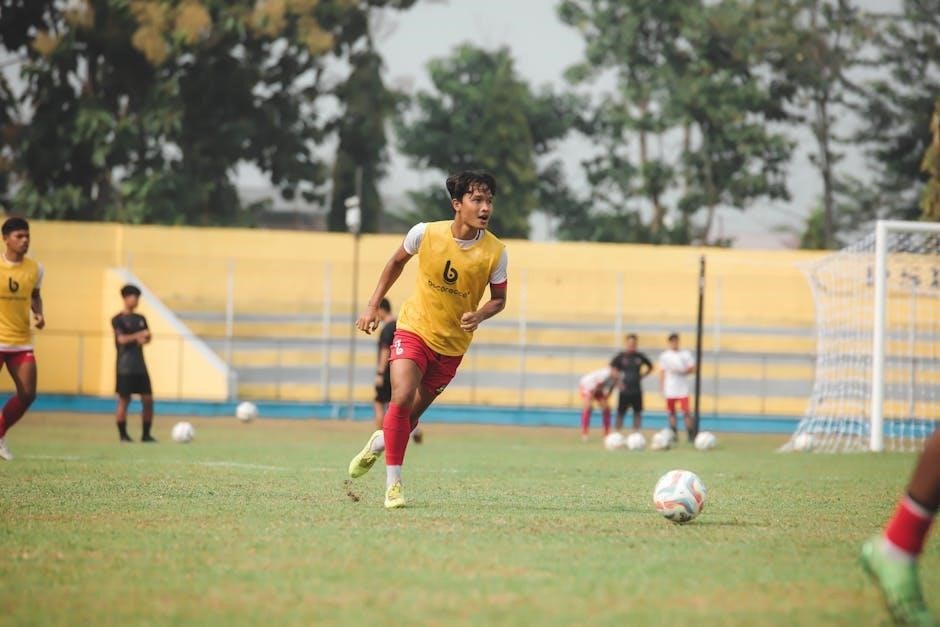Disciplinary action for not following instructions is a corrective measure taken when employees fail to meet performance or behavioral expectations‚ ensuring accountability and workplace adherence to standards.

1.1 Defining Disciplinary Action

Disciplinary action refers to formal measures taken by employers to address employee misconduct or failure to adhere to workplace policies. It involves imposing sanctions‚ such as warnings‚ suspensions‚ or dismissals‚ to correct unacceptable behavior. Disciplinary action is not limited to punishment but also aims to improve future compliance and maintain organizational standards. It is typically initiated when an employee violates company rules‚ fails to meet performance expectations‚ or engages in misconduct. The process is formal‚ ensuring fairness and consistency in addressing issues. Employers must adhere to legal and procedural guidelines to avoid unlawful practices. Disciplinary action serves as a tool to uphold accountability‚ protect workplace integrity‚ and ensure a productive environment.
1.2 Importance of Following Instructions in the Workplace
Following instructions in the workplace is essential for maintaining operational efficiency‚ ensuring safety‚ and upholding organizational standards. Clear guidelines help employees understand expectations‚ aligning their actions with company goals. When instructions are followed‚ it minimizes errors‚ reduces risks‚ and fosters a productive environment. Adhering to instructions also demonstrates accountability and commitment‚ which are critical for trust and teamwork. Failure to follow instructions can lead to disciplinary action‚ as it may result in misconduct‚ poor performance‚ or safety hazards. Consistent adherence to instructions ensures fairness‚ consistency‚ and a structured approach to addressing deviations. Ultimately‚ following instructions is fundamental for achieving organizational objectives and maintaining a disciplined‚ efficient workforce.

Reasons for Not Following Instructions
Employees may fail to follow instructions due to lack of clarity‚ misunderstandings‚ or poor communication. Behavioral issues‚ absence‚ or insufficient evidence can also contribute to non-compliance.
2.1 Common Reasons Employees Fail to Follow Instructions
Employees may fail to follow instructions due to poor communication‚ misunderstandings‚ or lack of clarity. Insufficient training or inadequate supervision can also contribute. Personal issues‚ such as stress or disengagement‚ may hinder comprehension or motivation. Additionally‚ absences or behavioral problems can lead to non-compliance; In some cases‚ employees might intentionally disregard instructions due to dissatisfaction or defiance. Lack of evidence or unclear policies can further complicate adherence. Employers must address these issues through proper disciplinary measures to ensure workplace standards and accountability‚ fostering a culture of compliance and productivity.
2.2 Consequences of Not Following Instructions
Failure to follow instructions can lead to disciplinary actions‚ ranging from verbal warnings to termination‚ depending on the severity. Legal implications may arise if non-compliance violates workplace policies or external regulations; Employees risk losing trust and credibility‚ harming career advancement. Repeated offenses can damage team morale and productivity‚ creating a disruptive work environment. Employers may face legal challenges if disciplinary actions are not handled fairly and consistently. Consequences extend beyond the individual‚ impacting overall organizational efficiency and reputation. Understanding these outcomes underscores the importance of adhering to instructions and addressing non-compliance through appropriate disciplinary measures.

The Disciplinary Action Process
The disciplinary action process involves investigation‚ evidence collection‚ hearings‚ and determining appropriate outcomes‚ ensuring fairness and consistency in addressing non-compliance with workplace instructions.
3.1 Investigation and Evidence Collection
Investigation and evidence collection are critical steps in addressing disciplinary action for not following instructions. Employers must gather all relevant facts to ensure fairness and accuracy. This involves interviewing witnesses‚ reviewing documentation‚ and assessing the severity of the misconduct. Evidence should be thorough and objective‚ avoiding bias or assumptions. The process must align with workplace policies and legal standards to protect both the employer and employee. Proper documentation ensures transparency and supports decisions made during disciplinary proceedings. Without sufficient evidence‚ disciplinary actions may be deemed unjust or unenforceable. Thus‚ a meticulous investigation is essential to maintain credibility and uphold organizational integrity.
3.2 Disciplinary Hearings
Disciplinary hearings are formal proceedings where employees are informed of allegations and given the opportunity to respond. Employers must ensure fairness and transparency‚ providing clear evidence and allowing the employee to present their case. The hearing typically involves HR representatives or management to maintain impartiality. Employees may bring a representative or legal counsel‚ depending on company policies. The purpose of the hearing is to determine whether disciplinary action is warranted and‚ if so‚ what form it should take. Outcomes may include warnings‚ suspensions‚ or termination‚ depending on the severity of the misconduct. Hearings must adhere to legal and organizational guidelines to protect both parties’ rights and ensure a just resolution.
3.3 Possible Outcomes of Disciplinary Action
Disciplinary action for not following instructions can result in various outcomes depending on the severity of the misconduct. Common outcomes include verbal or written warnings‚ which serve as formal notices of unacceptable behavior. In more serious cases‚ employees may face suspensions‚ either with or without pay‚ to reflect on their actions. Mandatory training or counseling may also be required to address performance or behavioral issues. Repeat offenses or severe violations can lead to termination of employment. The outcome is typically determined by the nature of the infraction‚ the employee’s disciplinary history‚ and the organization’s policies. Employers must ensure that the disciplinary action is fair‚ consistent‚ and aligned with legal standards to protect both the employee and the company.

Legal Considerations
Legal considerations in disciplinary action involve compliance with labor laws‚ ensuring due process‚ protecting employee rights‚ maintaining fairness‚ and avoiding legal disputes or claims.
4.1 Employer Rights and Responsibilities
Employers have the right to establish and enforce workplace policies‚ ensuring employees adhere to instructions and maintain expected standards. They must act fairly‚ providing clear communication of expectations and disciplinary procedures. Employers are responsible for investigating misconduct thoroughly‚ gathering evidence‚ and ensuring disciplinary actions are proportionate to offenses. They must comply with labor laws‚ protecting employees’ rights while addressing performance or behavioral issues. Employers must also document incidents and actions taken‚ maintaining transparency to prevent legal disputes. Balancing authority with fairness‚ employers uphold accountability while safeguarding employee protections‚ fostering a just and productive work environment.
4.2 Employee Rights and Protections
Employees have the right to fair treatment throughout any disciplinary process. They are entitled to clear communication of allegations‚ evidence‚ and potential outcomes. Workers must be granted the opportunity to respond to accusations‚ present their case‚ and provide evidence in their defense. Employers must ensure transparency and avoid bias in disciplinary proceedings. Employees are also protected from unfair or disproportionate actions‚ with the right to appeal decisions. Labor laws safeguard employees from retaliatory actions and ensure they are not penalized without just cause. Employees should receive written documentation of any disciplinary measures‚ maintaining their right to due process and natural justice. These protections aim to balance accountability with fairness‚ ensuring employees are treated equitably in all circumstances.

Best Practices for Employers

Employers should establish clear expectations‚ provide training‚ and ensure consistency in enforcing disciplinary policies. Open communication and fair treatment are essential to maintain trust and accountability.
- Communicate clearly: Ensure employees understand workplace rules and expectations.
- Provide training: Offer regular updates on policies and procedures.
- Ensure consistency: Apply disciplinary measures fairly across all employees.
- Offer feedback: Help employees improve through constructive criticism.
- Document actions: Keep detailed records of incidents and outcomes.
5.1 Communicating Expectations
Clear communication of workplace expectations is vital to prevent disciplinary issues. Employers should ensure employees fully understand company policies‚ job duties‚ and behavioral standards from the start. This can be achieved through detailed employee handbooks‚ regular training sessions‚ and ongoing updates on any policy changes. Employers should also provide specific examples of acceptable and unacceptable behavior to avoid ambiguity. By fostering an open-door policy‚ employees feel comfortable seeking clarification‚ reducing the likelihood of unintentional non-compliance. Regular reminders and updates via emails‚ meetings‚ or digital platforms can reinforce these expectations. Managers should lead by example‚ demonstrating adherence to the same rules they enforce. Clear communication not only promotes accountability but also ensures fairness in applying disciplinary measures when expectations are not met.
5.2 Documenting Incidents and Actions
Accurate documentation of incidents and actions is crucial in addressing disciplinary matters. Employers should maintain detailed records of any violations‚ including dates‚ times‚ and specific behaviors. This documentation should outline the nature of the misconduct‚ the steps taken to address it‚ and any discussions held with the employee. Consistent and fair documentation ensures transparency and accountability‚ protecting both the employer and employee. It also provides a clear audit trail in case of disputes or legal challenges. Employers should store these records securely‚ adhering to privacy laws‚ and ensure they are accessible for future reference. Regular updates to the documentation process can help maintain compliance with evolving workplace standards and legal requirements. Clear and thorough documentation is essential for upholding fairness and consistency in disciplinary procedures.


